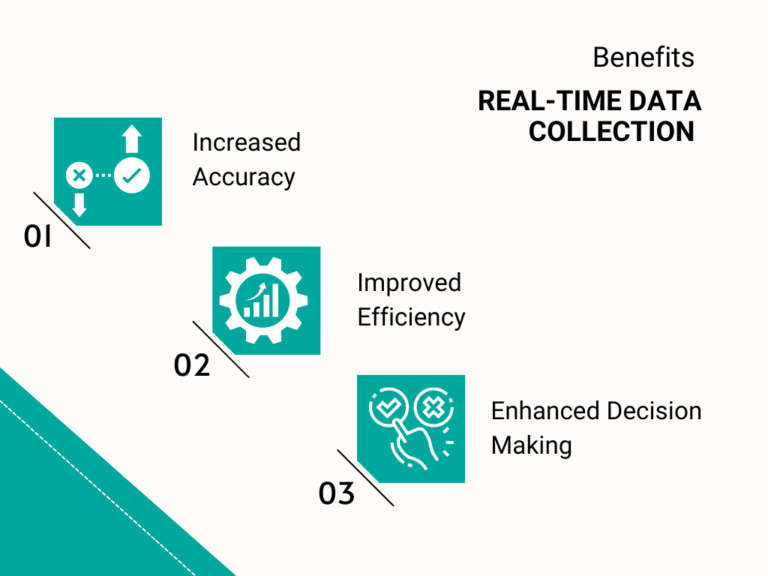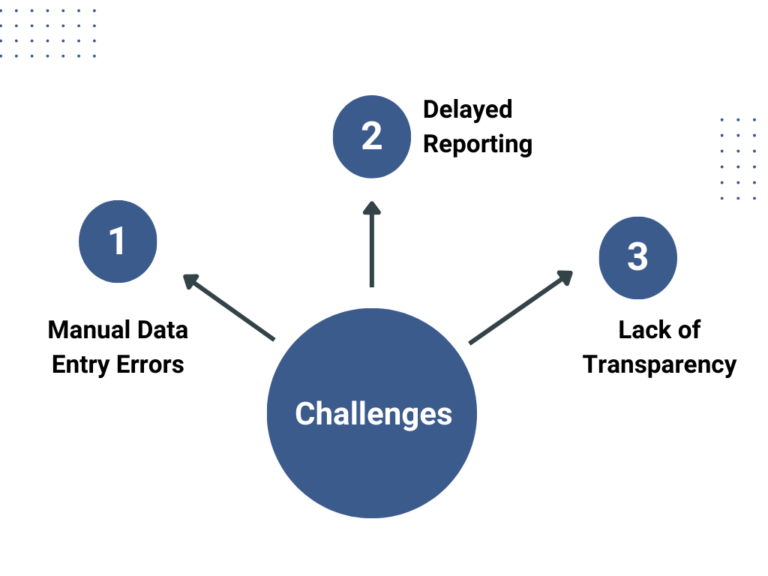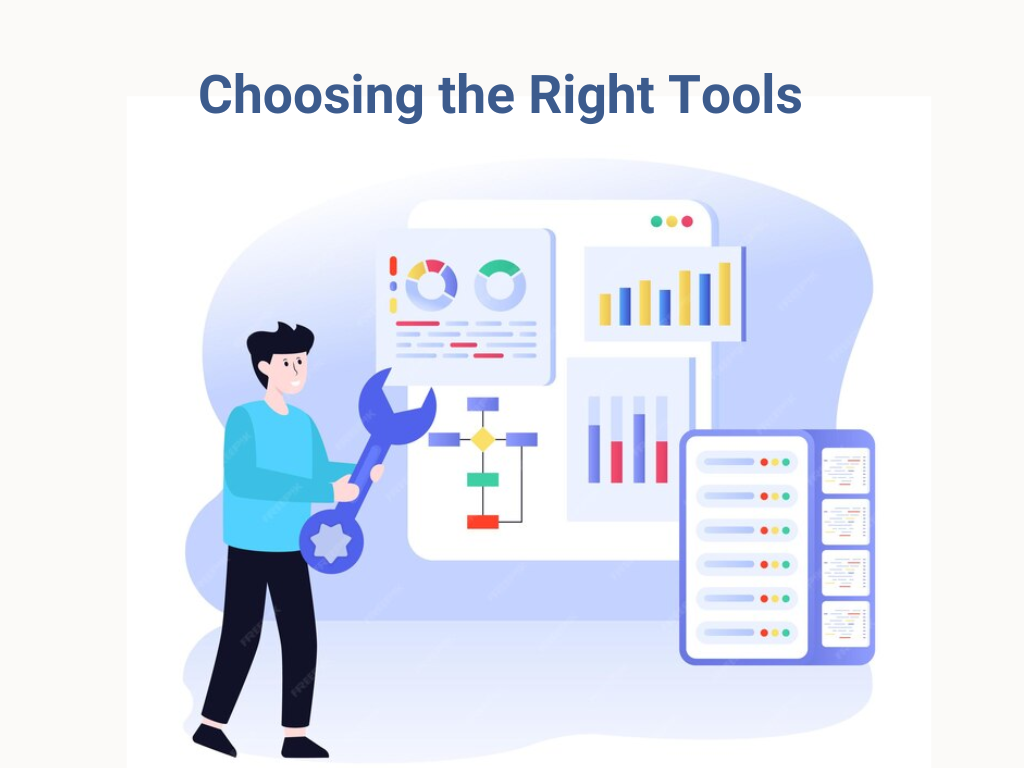Managing labor time in the field is crucial for businesses seeking to optimize productivity and reduce costs. In industries such as oil and gas and industrial field services, precise labor time management is key. It ensures that you allocate resources efficiently and your operations run smoothly.
Competition intensifies and customer expectations continue to rise. So, real-time data collection has become essential for staying ahead in the market.
Real-time data collection in field labor time management offers significant benefits that lead to improved operations and decision-making capabilities. Some of them are:

Real-time data collection ensures precise field service time tracking by providing immediate updates and verification of employee activities. This minimizes errors associated with manual data entry and allows for accurate recording of work hours, breaks, and task completion times.
The precision reduces discrepancies in payroll and billing. As a result, your organization can provide fair employee compensation and accurate billing for clients.
Having up-to-the-minute data on workforce activities helps reduce downtime and enhance productivity. Field workers can quickly update their status and report task completions. This enables managers to allocate resources more effectively and respond to issues as they arise.
This approach ensures that projects stay on schedule and that workforce productivity is high, ultimately lowering operational costs.
Real-time insights provide visibility into field operations as they happen. Managers can identify trends, spot potential issues, and adjust plans in response to changing conditions. This agility allows companies to proactively optimize their workflows, address challenges , and maintain a competitive edge.
Thus, decision-makers can ensure that their strategies stem from current and accurate information. This can lead to better outcomes and improved business performance.
Traditional time management methods have served businesses for many years. However, they often fall short in today’s fast-paced and data-driven environment.
These traditional methods come with several challenges that can hinder productivity and accuracy.

Manual data entry is prone to human error, leading to inaccuracies in recording labor hours and job details. Errors can result from illegible handwriting, incorrect data input, or misplaced records. This can cause discrepancies in payroll and billing.
Manual data inaccuracies require time-consuming corrections and can lead to employee dissatisfaction and client disputes.
The reliance on paper-based records or manual spreadsheets increases the risk of error. Therefore, it can become difficult to maintain reliable records over time.
Traditional time management systems often involve delays between the data collection time and when it becomes available for analysis. This lag can impede decision-making processes, as managers lack the real-time insights necessary to make informed adjustments.
Delayed reporting can result in inefficient resource allocation, missed deadlines, and lost opportunities for optimization. In industries, such as field services, time is critical. Therefore, such delays can significantly impact operational efficiency and customer satisfaction.
Outdated time management methods often struggle to maintain transparency. As a result, it becomes difficult for businesses to have a clear view of their operations.
Limited visibility into field activities can lead to miscommunication, misalignment of resources, and a lack of accountability. Without transparent processes, it can be challenging to track employee performance, verify work completion, and ensure compliance with company policies.
This lack of transparency can also undermine trust between management and employees which, in turn, can affect morale and productivity.
Real-time data collection solutions can significantly enhance the efficiency and accuracy of labor time management. They provide businesses with the ability to swiftly gather and process information. Some of the solutions include:
Mobile applications have revolutionized the way businesses capture real-time data in the field. Apps enable employees to log their work hours, report task completions, and update job statuses directly from their mobile devices.
This seamless integration of data collection into daily workflows eliminates the need for manual paperwork and reduces the likelihood of errors.
Mobile apps also provide immediate access to critical information, allowing field workers to make informed decisions quickly. Employees to stay connected and productive, no matter their location.
Furthermore, mobile apps can facilitate real-time communication between field workers and management, enhancing collaboration and coordination.
Features such as push notifications, instant messaging, and automated service reporting ensure that teams stay informed of changes and updates as they occur. This immediate flow of information helps prevent misunderstandings and miscommunication, improving the efficiency of field operations.
By leveraging mobile applications, businesses can streamline their processes, reduce downtime, and optimize resource allocation. As a result, they can achieve better overall employee performance and customer satisfaction.

Location-based technologies, such as GPS and geofencing, play a crucial role in enhancing time management. They provide accurate tracking of employee locations and activities.
GPS technology allows businesses to monitor the real-time location of field workers, ensuring they are on-site and on schedule. Such visibility helps prevent time theft and ensures that employees are working efficiently.
In addition, GPS data can. help optimize route planning, reduce travel time, and improve overall logistics. All of this can lead to increased productivity and reduced operational costs.
Geofencing, on the other hand, enables businesses to create virtual boundaries around specific locations. Then, they trigger automated actions when employees enter or exit these zones.
For example, geofencing can automatically clock employees in and out as they arrive at or leave a job site. Thus, it can streamline workforce time tracking and eliminate manual errors.
This technology can also send alerts to managers if employees leave designated areas unexpectedly, allowing for prompt intervention.
By integrating GPS and geofencing technologies, businesses can enhance their time management capabilities. Thus, they can ensure that their employees utilize resources effectively and efficiently.
The Internet of Things (IoT) has introduced a new dimension of real-time monitoring and data collection. It can send data to the cloud and provide businesses with unprecedented insights into their operations.
You can deploy IoT devices across various field locations to monitor equipment usage, track environmental conditions, and capture data on employee activities. These devices continuously collect and transmit data to centralized systems. They allow businesses to remotely monitor field operations and make informed decisions based on real-time information.
By leveraging IoT technology, companies can enhance the accuracy of their data, optimize resource allocation, and improve overall operational efficiency.
IoT devices also enable predictive maintenance, allowing businesses to take action on potential issues before they escalate into costly problems. By monitoring equipment performance in real time, companies can identify patterns and trends that indicate impending failures.
Additionally, IoT devices can facilitate compliance with safety regulations. They help monitor hazardous conditions and alert managers about potential risks.
Successfully implementing real-time data collection systems requires a strategic approach that consists of:
Your first step should be thoroughly assessing the specific needs of your business. This involves analyzing current workflows, identifying bottlenecks, and understanding the challenges that your workforce faces in the field.
Conduct interviews with key stakeholders and gather input from field workers. This can provide valuable insights into the areas where real-time data collection can have the most impact. It is also important to consider industry-specific requirements and regulatory compliance issues. They may affect your data collection practices.
Once you’ve identified your needs, prioritize the areas where real-time data collection will deliver the most significant benefits. This will help you effectively allocate resources and ensure that the implementation process aligns with your strategic business goals.
Selecting the right tools for real-time data collection is critical to achieving the desired outcomes. Take into consideration factors such as functionality, ease of integration with existing systems (KPA EHS, QuickBooks etc.), scalability, and user-friendliness.
Seek solutions that offer comprehensive features, such as mobile apps, GPS, and IoT devices for monitoring equipment and field activities. Additionally, tools that provide customizable dashboards and reporting capabilities can enhance data visualization and facilitate decision-making.
It is also essential to evaluate the reliability and support provided by technology vendors. Choose partners that offer robust customer service, regular updates, and a proven track record of successful implementations.
Conducting pilot tests with selected tools can help determine their effectiveness and suitability for your organization. By carefully considering these factors, you can choose the right real-time data collection tools that align with your operational needs and drive productivity improvements.

To ensure a smooth transition to real-time data collection, invest in comprehensive training programs for employees at all levels. They should cover the functionalities of the new tools, best practices for data entry and management, and the benefits of real-time data collection.
Providing hands-on training and ongoing support can help employees gain confidence in using the new systems and encourage widespread adoption.
In addition to training, foster a culture of openness and communication. It’ll help overcome resistance to change.
Involving employees in the implementation process and seeking their feedback can increase buy-in and reduce apprehension about new technologies. Recognizing and rewarding early adopters can also encourage others to embrace the change.
As businesses continue to face increasing pressures to improve operational efficiency and reduce costs, adopting real-time data collection is not only advantageous but essential. With it, companies can ensure that they remain agile and responsive in a dynamic market environment.
To experience the transformative benefits of real-time data collection firsthand, schedule a demo of FieldEquip. Discover how our innovative solutions can help your business enhance productivity, streamline processes, and achieve operational excellence.
Would you like to have a free demo or have any questions about FieldEquip?
US Corporate Headquarters 1011 S. Hwy. 6, Suite 117 Houston Texas 77077 US